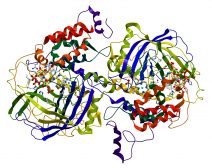Definition
noun
A parasitic ciliate belonging to the family Balantiididae, and the causative agent of the balantidiasis disease
Supplement
Balantidium coli is a ciliate belonging to the family Balantiididae. This taxonomic family belongs to the phylum Ciliophora. Balantidium coli is so far the only ciliate in the phylum known to cause disease in humans. The disease caused by the harboring of this ciliate species is called balantidiasis.
The life cycle of Balantidium coli is comprised of two stages: cyst stage and trophozoite stage. The life cycle begins at the cyst stage where the host ingests food or water contaminated with the cyst of Balantidium coli. The cyst is smaller than the trophozoite. It is spherical in shape and surrounded by a cyst wall. Prominent structures readily visible under a light microscope are macronucleus, cilia, and contractile vacuoles.
When the cyst reaches the small intestine, it develops into a trophozoite. The trophohozoite stage of Balantidium coli is characterized by having two nuclei, i.e. a long macronucleus and a spherical micronucleus. The trophozoite has an opening at the anterior end (called peristome), which leads to the mouth (called cytostome). The trophozoites colonize the large intestine and feed on the intestinal flora. The trophozoite may undergo encystation during dehydration of feces. Mature cysts released in the environment together with the feces are infective to the new host (humans, pigs, rats and other mammals).
Balantidiasis is a zoonotic disease. While it usually does not cause harm to the pig host, it may lead to balantidiasis. The symptom is usually either diarrhea or constipation.
Scientific classification:
- Domain: Eukaryota
- Phylum: Ciliophora
- Class: Litostomatea
- Order: Vestibuliferida
- Family: Balantiididae
- Genus: Balantidium
- Species: B. coli
See also:







